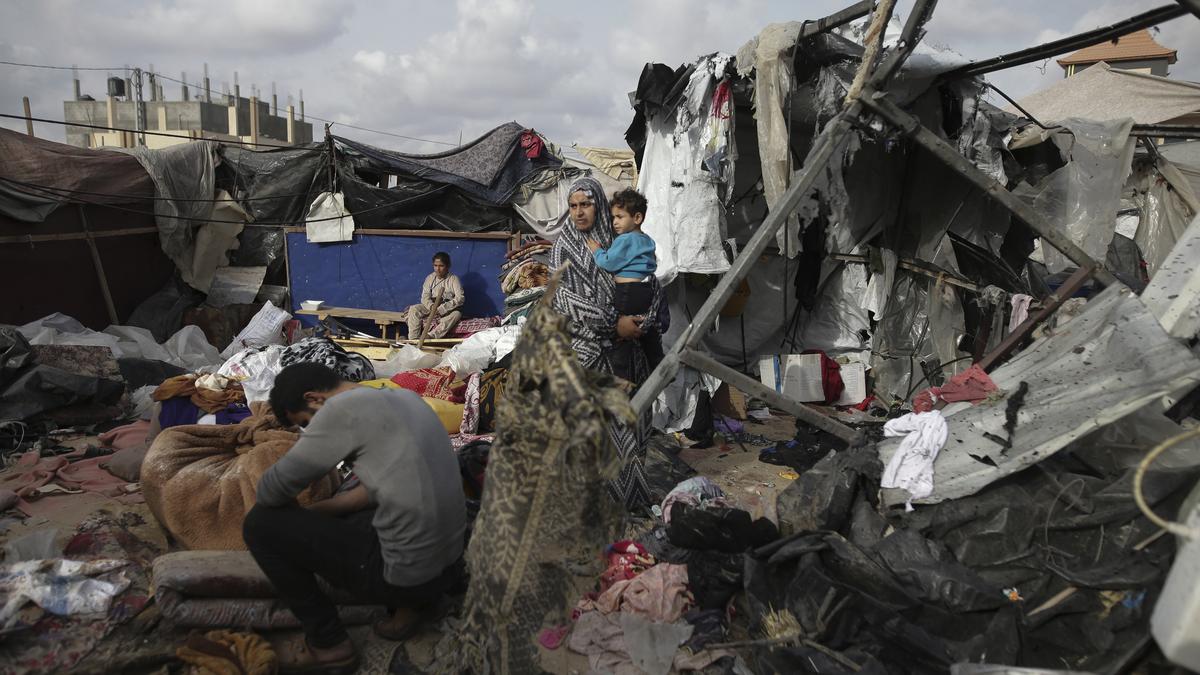Israeli forces hammered Rafah in southern Gaza with tanks and artillery on June 1, hours after U.S. President Joe Biden said Israel was offering a new roadmap towards a full ceasefire.
Shortly after Mr. Biden’s announcement, Israeli Prime Minister Benjamin Netanyahu insisted his country would still pursue the war until it had reached all its aims.
Also Read: Analysis | Benjamin Netanyahu: A Prime Minister always at war
He reiterated that position, saying that “Israel’s conditions for ending the war have not changed: the destruction of Hamas’s military and governing capabilities, the freeing of all hostages and ensuring that Gaza no longer poses a threat to Israel”.
Hamas, meanwhile, said it “views positively” the Israeli plan laid out by Mr. Biden.
In his first major address outlining a possible end to the nearly eight-month war, the U.S. President said Israel’s three-stage offer would begin with a six-week phase that would see Israeli forces withdraw from all populated areas of Gaza.
It would also see the “release of a number of hostages… in exchange for (the) release of hundreds of Palestinian prisoners”.
Israel and the Palestinians would then negotiate for a lasting ceasefire — but the truce would continue so long as talks are ongoing, Mr. Biden said.
The U.S. leader urged Hamas to accept the Israeli offer.
“It’s time for this war to end, for the day after to begin,” he said.
Netanyahu offered ‘safety net’
U.S. Secretary of State Antony Blinken called his counterparts from Jordan, Saudi Arabia and Turkey on Friday to press the deal.
UN chief Antonio Guterres “strongly hopes” the latest development “will lead to an agreement by the parties for lasting peace”, his spokesman Stephane Dujarric said.
German Foreign Minister Annalena Baerbock said the offer “provides a glimpse of hope and a possible path out of the war’s deadlock”, while EU chief Ursula von der Leyen welcomed a “balanced and realistic” approach to end the bloodshed.
Saudi Arabia stressed its “support for all efforts aimed at an immediate ceasefire” and the withdrawal of Israeli troops.
Indonesia, meanwhile, said it was ready to send “significant peacekeeping forces” and medical personnel to Gaza if a ceasefire is agreed.
But Mr. Netanyahu took issue with Mr. Biden’s presentation of what was on the table, insisting on Friday the transition from one stage to the next was “conditional” and crafted to allow Israel to maintain its war aims.
“The Prime Minister authorised the negotiating team to present an outline for achieving (the return of hostages), while insisting that the war will not end until all of its goals are achieved,” Mr. Netanyahu’s office said.
“The exact outline proposed by Israel, including the conditional transition from stage to stage, allows Israel to maintain these principles.”
Israel has repeatedly vowed to destroy Hamas since the Palestinian militant group attacked southern Israel on October 7.
Israeli opposition leader Yair Lapid said the government “cannot ignore Biden’s important speech” and should accept the proposed deal, vowing to back Netanyahu if his far-right coalition partners quit over it.
“I remind Netanyahu that he has our safety net for a hostage deal,” Lapid said Saturday on social media platform X.
Intense shelling
Israel sent tanks and troops into Rafah in early May, ignoring concerns over the safety of displaced Palestinian civilians sheltering in the city on the Egyptian border.
On Saturday, residents reported tank fire in the Tal al-Sultan neighbourhood in west Rafah, while witnesses in the east and centre of Rafah described intense shelling.
“From the early hours of the night until this morning, the aerial and artillery bombardment has not stopped for a single moment”, a resident from west Rafah told AFP on condition of anonymity.
“There are a number of occupation (Israeli) snipers in high-rise buildings overseeing all areas of Tal al-Sultan… making the situation very dangerous”, the resident added.
There was also shelling and gunfire from the Israeli army in Gaza City, in the north of the territory, an AFP reporter said.
Before the Rafah offensive began, the United Nations said up to 1.4 million people were sheltering in the city.
Since then, one million have fled the area, the UN agency for Palestinian refugees, UNRWA, has said.
The Israeli seizure of the Rafah crossing has further slowed sporadic deliveries of aid for Gaza’s 2.4 million people and effectively shuttered the territory’s main exit point.
‘Everything is ashes’
Israel said last week that aid deliveries had been stepped up.
But Mr. Blinken acknowledged on Friday that the humanitarian situation was “dire” despite U.S. efforts to bring in more assistance.
Egyptian state-linked Al-Qahera News said Cairo will host a meeting with Israeli and U.S. officials on Sunday to discuss the reopening of the Rafah crossing.
The World Food Programme said daily life had become “apocalyptic” in parts of southern Gaza.
The Gaza war was sparked by Hamas’s unprecedented October 7 attack, which resulted in the deaths of 1,189 people, mostly civilians, according to an AFP tally based on Israeli official figures.
Militants also took 252 hostages, 121 of whom remain in Gaza, including 37 the army says are dead.
Israel’s retaliatory offensive has killed at least 36,379 people in Gaza, mostly civilians, according to the Hamas-run territory’s health ministry.
In northern Gaza, witnesses said that after carrying out a three-week operation in the town of Jabalia and its neighbouring refugee camp, troops had ordered residents of nearby Beit Hanun to evacuate ahead of an imminent assault.
The Israeli Army said troops “completed their mission in eastern Jabalia and began preparation for continued operations in the Gaza Strip”.
Jabalia shopkeeper Belal al-Kahlot said there was nothing left of his store after the Israeli operation.
“Everything is ashes,” he said.











